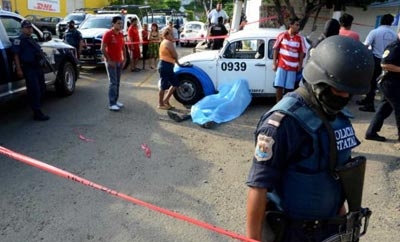An investigative report by Milenio suggests that of the 60,000 people killed in the last six years in Mexico’s fight against organized crime, nearly half have not been identified by the government. It also finds evidence that state officials may be tampering with the public record of these deaths.
The months-long investigation published in October found that at least 24,102 of the 60,000 Mexicans that have died in circumstances related to the fight against organized crime since 2006, have yet to be identified, and are classified by officials as “NN,” (“ningun nombre,” or no name). Below is a map compiled by the paper of the states with the highest reported concentrations of these unidentified victims.
 Even more alarming, this is a conservative estimate. State officials were extremely uncooperative with the investigation. The state of Tamaulipas, for example, simply refused to release any data on the number of NNs to the newspaper, saying that it was a federal matter and not the state’s responsibility.
Even more alarming, this is a conservative estimate. State officials were extremely uncooperative with the investigation. The state of Tamaulipas, for example, simply refused to release any data on the number of NNs to the newspaper, saying that it was a federal matter and not the state’s responsibility.
The government of Veracruz also put up a fight against releasing the data to Milenio, arguing that to do so would put its officials “at risk” and potentially violate the privacy of the victims. While a freedom of information request filed by the paper was approved in Mexican courts, the state has yet to provide a comprehensive list of cases of unidentified murder victims. The local governments 30 of 212 municipalities in Veracruz did provide information to Milenio, however; according to this data, it was the state with the most unidentified victims in the country, with 5,245.
Even in cases where state governments did provide data on NNs, the statistics are suspect. The Attorney General of Sinaloa, for instance, reported that just 54 dead bodies had not been identified in 2011, with a total of 227 since 2006. But a review of the records compiled by the state’s forensic official contradicted this, revealing that 332 murder victims over the past six years have yet to be identified. It also documented 91 unidentified murder victims in 2011, nearly twice the number reported by Sinaloan authorities for that year.
In short, the 24,102 figure does not include complete registers in Mexico State, Guerrero, Michoacan, Sinaloa and Tamaulipas, states which regularly see some of the highest levels of organized crime-related violence. This suggests that the real number of unidentified victims much higher.
InSight Crime Analysis
The Milenio investigation provides a sobering look at the shoddy rule of law in Mexico. The number of unidentified victims is a reflection of the little forensic evidence collected at crime scenes; provokes questions about investigations that never got started or were diverted along the way; and gives us a glimpse of the lack of resources or will investigative authorities have to find out who the victims were, a crucial step in determining motive.
This lack of data on nearly half of the victims also puts the government’s traditional narrative about those victims in question. That narrative — that these victims are somehow connected to organized crime — is a central part of the justification of the war that has followed. To be sure, outgoing President Felipe Calderon has maintained that the uptick in violence under his administration is an indication of success, and insisted that the vast majority of those killed in the past six years have been linked to criminal organizations.
But it is a slippery slope. Linking a homicide to the Mexico’s ongoing war on organized crime may be politically expedient and gives security forces plausible deniability in what is at times a messy fight, but it is extremely difficult to determine who is who and inevitably depends upon a certain amount of speculation, subjectivity and — as we can see from some of the states’ responses to Milenio’s requests — political maneuvering. What it is not based on, as Milenio’s reporting shows, is actual data.
This is one of the major reasons why analysts have criticized official homicide statistics in the past, and why Mexican law enforcement authorities have been increasingly less than forthcoming about how they distinguish between “organized crime-related homicides” and other homicides. It also may help explain the reticence on the part of state governments to provide accurate data on these deaths.
President-elect Enrique Peña Nieto campaigned on promises of improved security and transparency, and the burden of standing up to Mexico’s organized crime falls on him beginning in December. A more difficult task, however, may be to face the reality that the country’s judicial system is broken. More than 80 percent of all murder cases in Mexico, regardless of whether they are linked to the drug trade, go unsolved. Even when officials have arrested a suspect in a crime, at least 90 percent have been subsequently released. The government has been attempting to oversee a complete overhaul of the country’s court system, but progress is slow, and it remains to be seen if Peña Nieto will have any more success with reform efforts than his predecessor.

